CROSS OVER THE SWAMPS
Although many of the world’s wetlands have disappeared due to deforestation, they can still be found on all continents except Antarctica. These places are often distinguished by an amazing biological diversity, there is an abundance of fish and many plants. However, stagnant waters with large amounts of decaying organic matter are excellent incubators for parasites, bacteria and insects – disease carriers.
In this area, water will surround you everywhere. Therefore, most of the equipment will be specific. First and foremost, both you and your belongings should be as dry as possible. The water here is always colder than the temperature of the human body, from which prolonged exposure to it can lead to hypothermia even in warm weather.
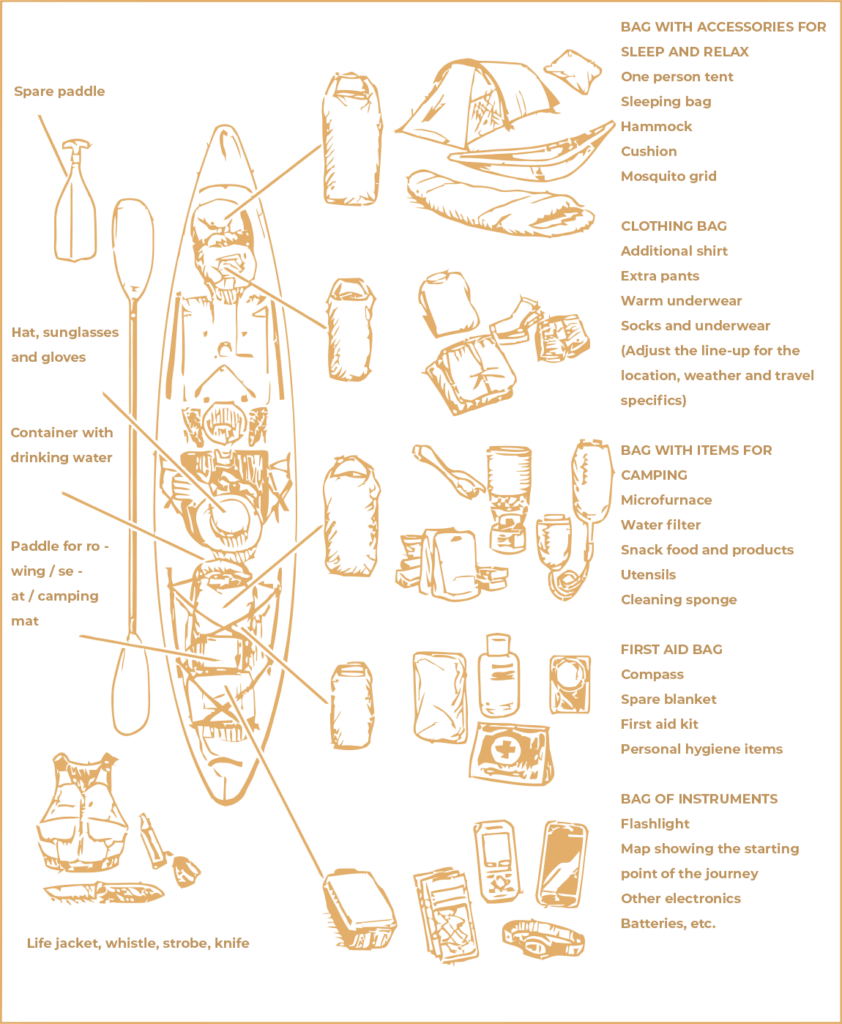
Use waterproof bags to keep things dry. If you have several of these bags, you can easily distribute them on your kayak. It is worth practicing in advance in your actions in case of overturn of the floating craft. Be sure to tie your gear – as a precaution. Put a knife, whistle, and strobe into the pockets of your lifejacket. If your boat capsizes or you falls from it into the water, you can use a knife to get rid of algae or other foreign matter that you find in the water, and use a whistle or stroboscope to send a distress signal.
Even if you are cross over shallow water, towing the boat is preferable to carrying, albeit a smaller load, on yourself.
If you run aground in a remote area, do not sacrifice some of the cargo. You may mispredict how long it will take to rely on the survival tools you bring with you.
Filtration of water
The question of whether it is necessary to purify water in a swampy area or not is not even discussed. There is a lot of water in this environment, but it is almost certainly home to many harmful parasites and bacteria. Swamp fever (a generic term for malaria, leptospirosis and mumps), the Everglades virus, also known as Venezuelan equine encephalomyelitis, and cholera are just a few of the diseases that can be obtained with water from swamps. These diseases can lead to very serious physical and sometimes neurological consequences.
Your kit should definitely include a water filtration kit and a stove to clean it by boiling.
The safest way to purify water is to boil it.
As a last resort, you can resort to an impromptu filtration system, made from the materials at hand: a plastic bottle (they often float in swamps located not too far from cities), sock, charcoal and small stones found along the coastline. The most important and irreplaceable layer in this makeshift filtration system is charcoal, well known for its ability to absorb a wide range of toxic substances. In its “activated” form, that is, when it is processed so that it can absorb toxic substances as efficiently as possible, charcoal is the main ingredient in most commercial filtration systems and is also used in the treatment of a number of painful conditions, from flatulence to poisoning.
Stored barbecue fuel briquettes are chemically treated and therefore not suitable as a filter bed.
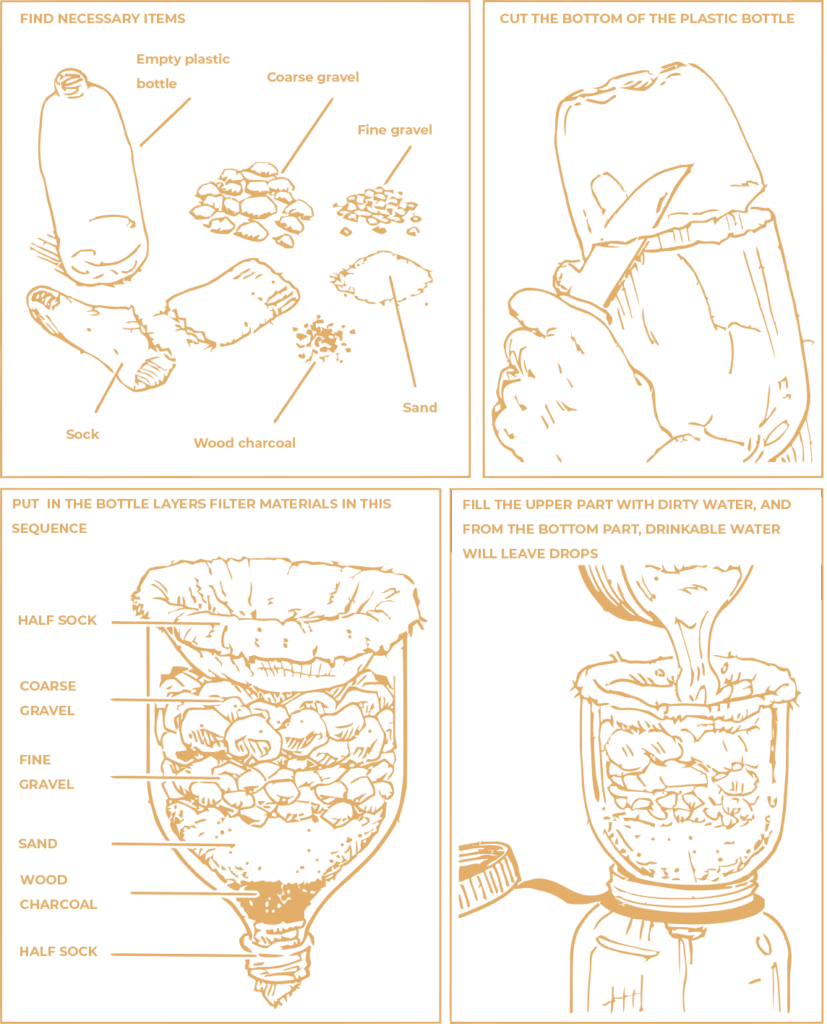
To cook charcoal yourself, light a fire on the shore and wait until the wood turns to charcoal. Arrange the layers in your filtration system so that the largest particles are in the wider part of the bottle, trapping the larger debris, and the smallest ones in the neck. When you pour water through such a filtration system, droplets appearing at the bottom should form slowly. If the outlet water flow is stable enough, it means that your filtration system is too porous.
Making fire with a mobile phone
On a hike, the phone can be used for a variety of purposes: call for help, find a way to a safe place, talk to loved ones. But even after its battery is completely discharged and it stops working for its intended purpose, the mobile phone can be used as a kind of lifeline.
Thanks to powerful batteries with valuable chemical components, personal electronic devices such as telephones, tablets and navigation systems can be used to start a fire long after they have ceased to function. Thanks to lithium ions, batteries have such a high energy density that when closed contacts, their contents begin to heat up, and then burn with the appearance of a flame.
Remove the battery from the device, and then try to use up the remaining charge by connecting the positive and negative terminals together using a knife or other metal object equipped with a handle that does not conduct electricity. The spark that appears should be enough to make the tinder smoke, but if you’re not careful, there can be an unwanted side effect – a pretty strong electric shock.
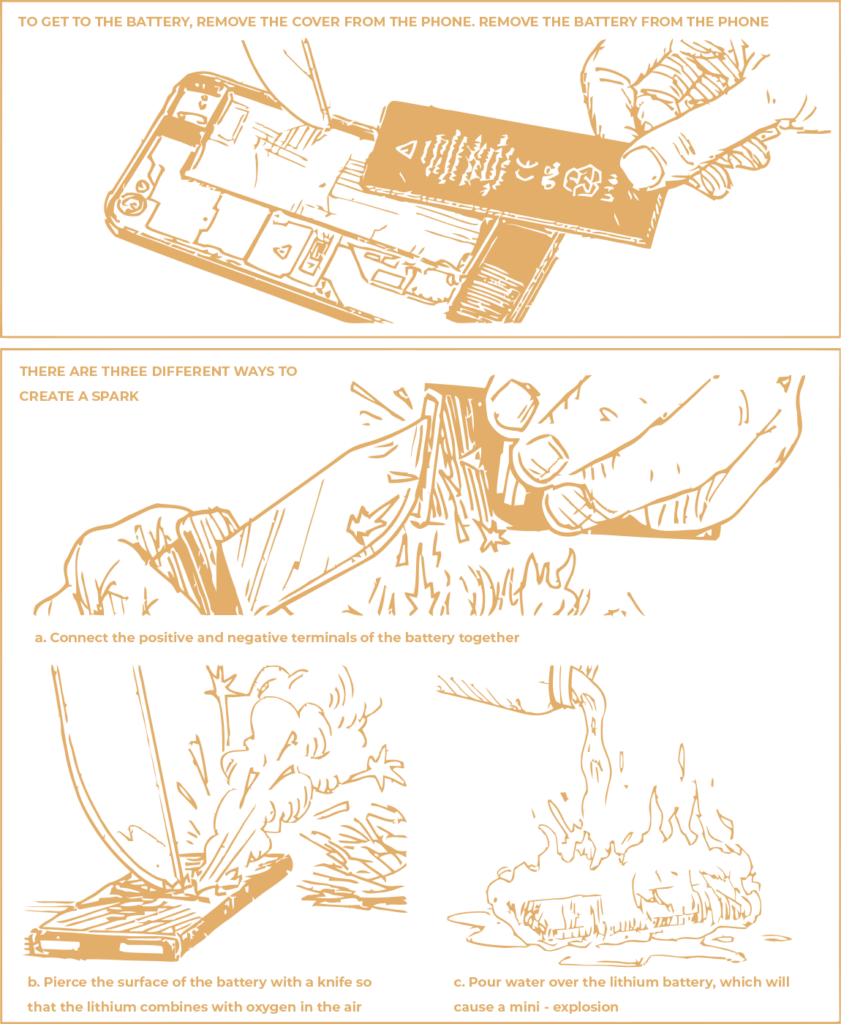
If this does not work, place the battery on the ground and pierce it with the tip of a knife. In this case, protection will be violated and a short circuit will occur in the battery, which will cause a sharp short-term burst of energy. A similar effect, which will manifest itself even more strongly, in the form of a microexplosion, can be caused by pouring water on the battery. The liquid disrupts the protection circuitry, which prevents the battery cells from contacting each other, resulting in voltage peaks.
Move quickly away from the battery in this condition: a flame will be released and toxic compounds will be released.
The fire caused by lithium ions is dangerous, toxic and difficult to extinguish. Therefore, the described methods should be resorted to only as a last resort when it really comes to survival.
Food extraction
The biologically diverse environment of this area is home to many plants and a wide variety of living things – from reptiles, fish and amphibians to birds and insects, the sounds of which are heard everywhere. One of these inhabitants in many types of swamps is the frog. This creature, whose legs are considered a delicacy, is not difficult to catch.
However, in the tropics, beware of poisonous frogs. Small and brightly colored, they release deadly poisons that can cause severe consequences for the body such as convulsions, paralysis and heart attack.
Golden poison dart frog can release so much toxin through its skin glands that it is enough to send ten adults to the next world.
In the past, the indigenous population used this secretion as a deadly poison for their arrows. Pharmaceutical companies are now using this poison as the basis for powerful pain relievers.
Avoid toads, as their parotid glands secrete toxic substances. Squat and wide, toads are considered less dangerous to humans than poisonous frogs, but both of them can threaten you with death.
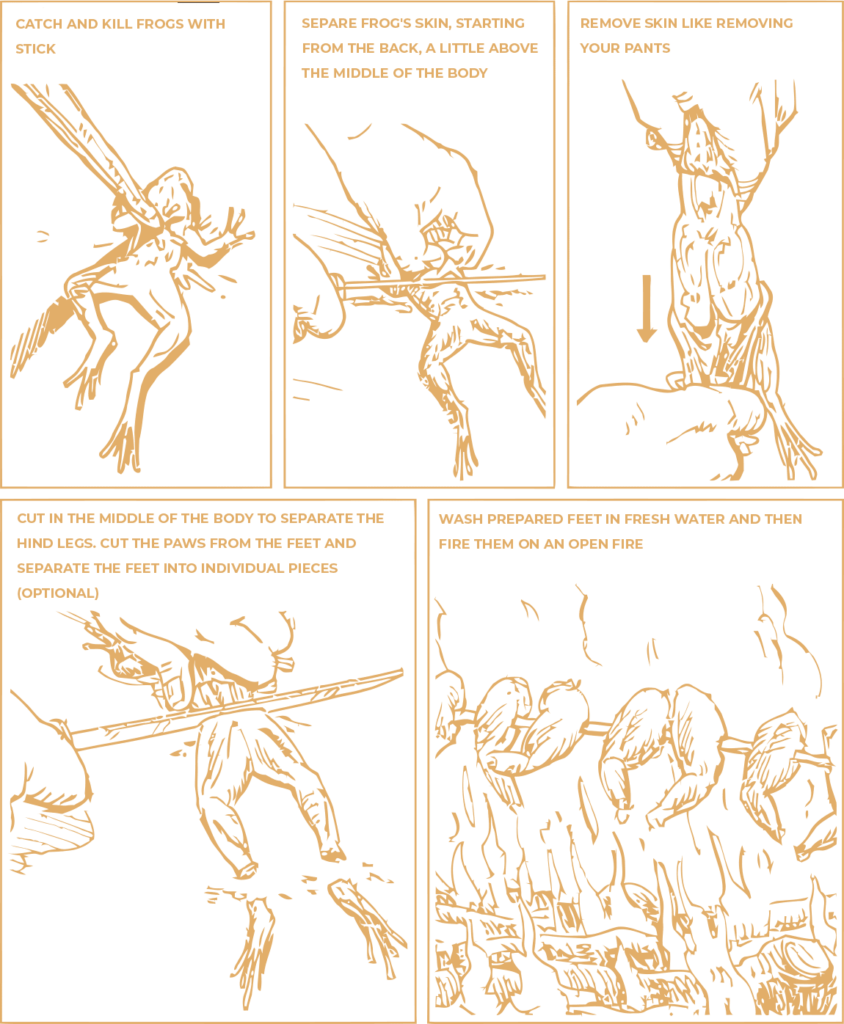
Frogs prefer standing water to running water. Look for them on muddy shores near water or, in colder months, under logs and rocks. These amphibians feed on insects and earthworms and can therefore be found by observing the latter. Frogs are usually most active at night, but hunting them in the dark without a light source is impractical: bright light will not only help you avoid possible injury, but also make the frog freeze in place. Use a sharpened stick to hunting.
You can prick frogs directly from your floating craft or from located on a elevation shelter.
Building an elevated sleeping area
If you can hardly reach the shore before nightfall and you are likely must to spend the night in a swampy area, you need to build a temporary shelter over the water. If you decide to spend the night on a boat, get ready for the cold, high humidity and possible collisions with fish-eating muzzles and even alligators.
We will proceed from the assumption that you are a prudent person and put a hammock in your backpack. In this case, you may want to build a roof over your sleeping area to protect you from some natural phenomena. In such conditions, a shelf can be useful as a working surface on which you can start a fire (in a closed container such as a kettle), in addition, you can fish from it or even repair your ship if it needs repair.
To build all of the above structures, look for three trees standing next to each other, forming a triangle with dimensions sufficient for sleeping. Choose three long, straight branches that can reach from tree to tree. However, you may have to climb trees several times to find suitable branches. Cut off the ones that suit you, and use a parachute cord, rope, vines or tree bast to tie them in the right places to the trees.
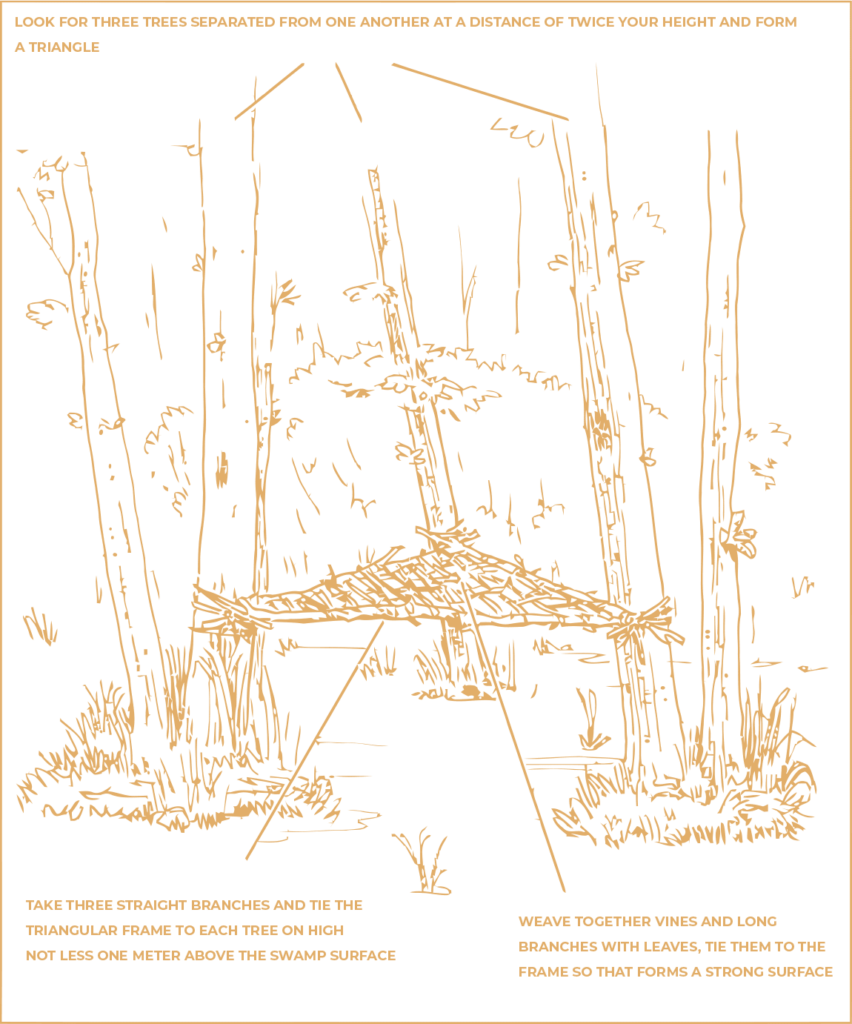
To increase the strength of your shelter, tie each branch from tree to tree separately. Place a tarp on the resulting frame, which must be wrapped around the edges and secured. You can create a resilient surface in a different way: using a frame as a base, weave and tie together vines and long branches with leaves.
If you want to leave behind signs by which potential rescuers could orient themselves, do not disassemble the structure you have created when going to the next parking lot. But if you do not want to be found, of course, it must be dismantled.






